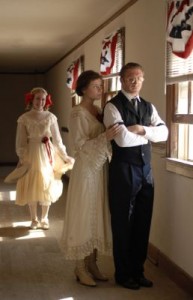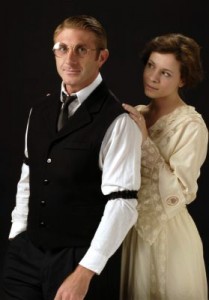
The lynching of Jewish Northerner Leo Frank, falsely convicted of murdering 13-year-old Georgia factory worker Mary Phagan, remains today, nearly a century later, one of the most serious miscarriages of justice (and instances of anti-Semitism) in United States history. Powerful stuff for a Broadway musical, and one that would seem, at least on paper, more than a bit of a downer. Parade (with music and lyrics by Jason Robert Brown and book by Alfred Uhry) was a hard sell on Broadway. If Fosse was the “feel-good” musical of 1999, then a show with such grim subject matter as Parade was pretty much its antithesis, and closed after 85 performances.
Parade’s all too brief run on Broadway was a miscarriage of justice of its own sort, for Parade (which was co-conceived and directed on Broadway by legendary Harold Prince) is one of the most powerful and compelling American musicals ever. It scored a justifiable 9 Tony nominations and won in 2 categories, for best book and best score. Clive Barnes in the New York Post called Parade “a defining moment in Broadway theater” and a London revival last year received nearly unanimous critical raves.
With a brilliant Los Angeles premiere production just opened at Palos Verdes’ Neighborhood Playhouse, local audiences will finally get a chance to experience the power that is Parade.
Director Brady Schwind has assembled a superlative cast, headed by Broadway’s amazing Craig D’Amico, backed by a 12-piece orchestra and featuring razzle-dazzle choreography by Imara Quinonez to make this long awaited L.A. premiere a front-runner for Best Musical of 2008.
No contemporary musical theater composer writes songs better than Brown (13, The Last Five Years, Songs For A New World), and Parade is easily his strongest and most varied score, ranging from gospel to pop rock to rhythm and blues to emotional ballads. Likewise, no one writes with more insight about being Jewish in the South than Uhry, whose book proves the playwright as adept at the dramatic as Driving Miss Daisy and The Last Night Of Ballyhoo proved him at comedy. Uhry’s book moves back and forth through time, as flashbacks reveal the events leading up to Frank’s arrest and trial and we meet the musical’s many characters, each of whom played an important role in the case and each of whom gets his or her center-stage moment to shine.
In a powerful prologue, a young confederate soldier (a fine Michael Tushous) sings a hymn to Georgia, “The Old Red Hills Of Home,” morphing into his elderly self (the excellent David Fairchild, who also plays Judge Leonard Roan), reminding us that the Civil War was not a distant memory at the time of Frank’s trial, but a very real memory for the citizens of Atlanta.
Frankie Epps (a handsome and peppy Ryan Amador) invites Mary Phagan (lovely 9th grader Alissa Anderegg) to “The Picture Show,” but Mary never arrives. Soon after, janitor Newt Lee (a powerful Loren Smith) is being interrogated (“I Am Trying To Remember”) as reporter Britt Craig (James Larsen, magnetic) touts “Big News!” in Atlanta. The golden voiced Amador returns to sing the emotional “It Don’t Make Sense,” followed by “Watson’s Lullaby,” performed by power-hungry newspaper editor Tom Watson (Chris O’Connor, personifying the evil of prejudice).
Michael Hovance is riveting as prosecutor Hugh Dorsey (“Somethin’ Ain’t Right” and “Twenty Miles From Marietta”). Talented teenage trio Megan Dorn-Wallenstein, Carly Menkin, and Marcy Agreen invent an incriminating invitation by Frank to “Come Up To My Office,” a musical number all the more powerful for being so jaunty. Aileen-Marie Scott does her finest work yet as Mary’s mother, singing her heart and soul out in the devastating “My Child Will Forgive Me.”
In a show-stoppingly jazzy “That’s What He Said,” charismatic scene-stealer Tareek Lee Holmes (as factory worker Jim Conley) concocts the elaborate lie that sealed Frank’s fate.
The sensational Ross Love and Tawny Dolley join Smith and Holmes in the gospel-inspired “A Rumblin’ and a Rollin’,” which recounts the influx of Northerners brought South by the Frank case. Michael Tatlock is in fine voice as Governor John Slaton in “Pretty Music,” a lively dance number which precedes Judge Roan’s moving plea to Slayton to commute Frank’s sentence (“Letter To The Governor”).
Though Parade is the epitome of an “ensemble show,” showcasing each and every member of the cast (which also includes the uniformly fine Rachel Baumstein, Laura Hathaway, Lizzie Jester, Alison Matizza, Rachel Mereness, Leslie Morris, Jessica Plotkin, Michael Prohaska, Gordon Wells, and USC’s dynamic duo Keith Barletta and Ian Littleworth), it is the roles of Leo and Lucille Frank which provide Parade’s heart and emotional punch.
In D’Amico, featured on Broadway in a pair of revivals (Annie Get Your Gun and Fiddler On The Roof), director Schwind has found a performer of depth and power, with the acting and vocal chops (and star quality) to turn this odd, reserved outsider from anti-hero to hero. It is a performance that starts out strong and only gains in power, climaxing in Parade’s devastating yet inspiring finale.
Recent Loyola Marymount grad Emily Olson’s youth and petite stature make Lucille Frank’s transformation from shrinking violet to her husband’s greatest advocate and near savior all the more powerful. Though Olson’s lovely un-miked voice does not always carry above the orchestral accompaniment, her performance is one of grace and strength.
Actually, Olson is not the only performer impacted by Parade’s being staged without amplification. The Neighborhood Playhouse’s acoustics and the size of the upstage (mostly hidden) orchestra do occasionally make dialog and vocal solos hard to hear, yet miking the performers might have proved equally problematic.
The Neighborhood Playhouse’s home at Palos Verdes’ historic Neighborhood Church does prove itself an ideal venue in at least one important respect. Its architecture and layout make for an easy transformation (thanks to Michael Tushous’s inventive scenic design) into a 1913 Georgia courthouse, ceiling fans and all.
Under Schwind’s inspired direction, most cast members never leave the stage, observing when not the focus of attention, transforming the set into numerous locales, singing, dancing, bringing history to life. Schwind’s creative use of silhouetted figures behind the upstage courtroom backdrop also proves effective, as in a chain-gang prison sequence as well as in a fantasy song-and-dance number in which Frank (sporting devil horns) seduces Mary. Though Parade runs a full three hours (including intermission), there isn’t a boring moment in it. Quite the contrary, despite our knowledge of the tragic outcome of Frank’s case, we remain riveted, and with Brown’s eclectic score including numerous upbeat, uptempo numbers and Qinonez’s choreography demonstrating the cast’s assured footwork, there are many bright moments amidst the somber reality of Frank’s trial.
David Sateren’s musical direction is impeccable, and what small theater musical ever has an orchestra of this size? Karen Cornejo’s costumes, designed and executed specifically for this production, are an exquisite medley of early 20th Century fashion and styles. Alicia Harrek’s lighting, Tushous’ set, Michael Aldapa’s hair design, and the contributions of everyone involved in this production are deserving of the highest praise.
Anyone who loves the art form that is the American Musical owes it to him/herself to drive to Palos Verdes (the ocean view from the cliffs alone is worth making the trip) to see this landmark show, done full justice by The Neighborhood Playhouse’s absolutely heartrending and breathtaking production.
The Neighborhood Church, 415 Paseo Del Mar, Palos Verdes Estates.
www.NeighborhoodPlayhouse.net
–Steven Stanley
July 11, 2008




 Since 2007, Steven Stanley's StageSceneLA.com has spotlighted the best in Southern California theater via reviews, interviews, and its annual StageSceneLA Scenies.
Since 2007, Steven Stanley's StageSceneLA.com has spotlighted the best in Southern California theater via reviews, interviews, and its annual StageSceneLA Scenies.







 COPYRIGHT 2024 STEVEN STANLEY :: DESIGN BY
COPYRIGHT 2024 STEVEN STANLEY :: DESIGN BY